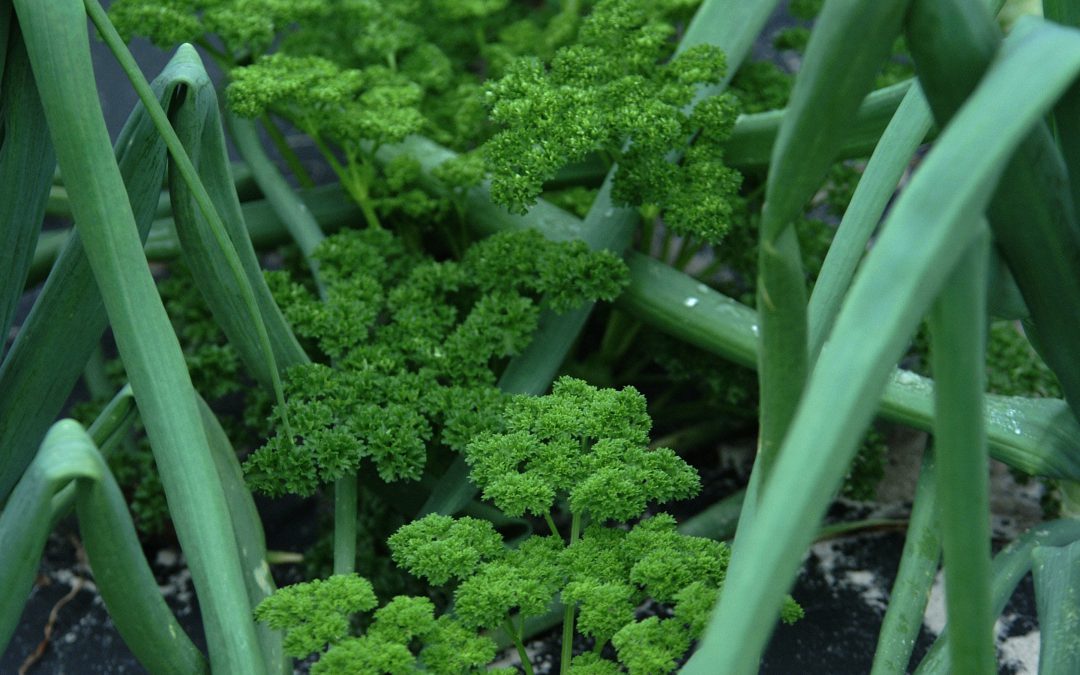
by Ashley Stonecipher | Dec 10, 2021
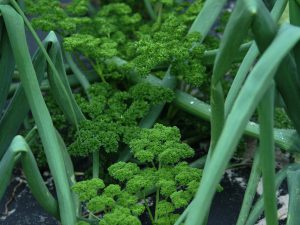
Multi-cropping at a Gainesville, FL organic garden.
As we go into the winter here in the Panhandle the following herbs will do well: cilantro, parsley, fennel, thyme, chives, oregano, sage and dill. Basil is a popular herb but will need to be inside by a kitchen window this time of year. It will drop leaves below 40 degrees F.
Cilantro: Needs full to partial sun, excellent soil drainage, and can be sued at 6 inches in height. The dry seeds are used to make the spice Coriander.
Parsley: Loves the cool weather and will bloom in the spring. Parsley likes afternoon shade. The seeds do take longer to germinate so do not give up on this plant. The root has a strong flavor and is used in holiday dishes. Parsley is beneficial to your health and contain vitamins A, C, K and is also high in calcium and iron.
Fennel: Needs full sun and moist soil. Fennel should not be planted near dill or cilantro because it will cross pollinate and reduce seed production. Fennel is good for digestive health and the shoots, leaves, and seeds are all useful in cooking. This plant also is host to the black swallowtail caterpillar.
Thyme: Needs full sun, well-drained soil and is extremely drought tolerant. Thyme does very well in a windowsill. This plant is highly attractive to bees and creates a delicious honey.
Chives: Prefers sunlight and well drained soil. This can be used for an onion or garlic flavor to your dish. It will need to be divided every couple of years since it grows so well here. Also, very good mixed into butter or cream cheese as a spread.
Oregano: This is the most widely used culinary and medicinal herb. It has tiny purple flowers that bloom all summer. It needs full sun and well-drained soil. Its best flavor is when you harvest the leaves as the flower buds form. The stems can be cut and dried and used in the cooking as well.
Sage: This herb needs full sun and very well drained soil. It is a small silvery leaf plant that is a very popular seasoning during Thanksgiving for turkey. It is also good on other poultry.
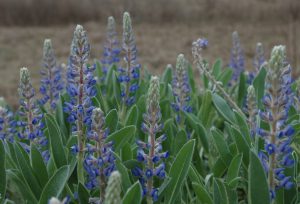
Sage. UF/IFAS Photo: Josh Wickham.
Dill: This herb likes full sun as well and serves as a host plant to the Black Swallowtail Butterfly. It is a very aromatic herb used both for its leaves and the seeds.
When harvesting herbs look for leaves that are young and tender with good color. Wash your herbs and pick them as you need them for best flavor, unless you plan to store them. When storing fresh herbs, it is important to know that they lose their flavor over time. They will store in the refrigerator from 1-3 weeks, freezer, and if dried can last up to 3 years.
Source: https://gardeningsolutions.ifas.ufl.edu/plants/edibles/ vegetables/herbs.html
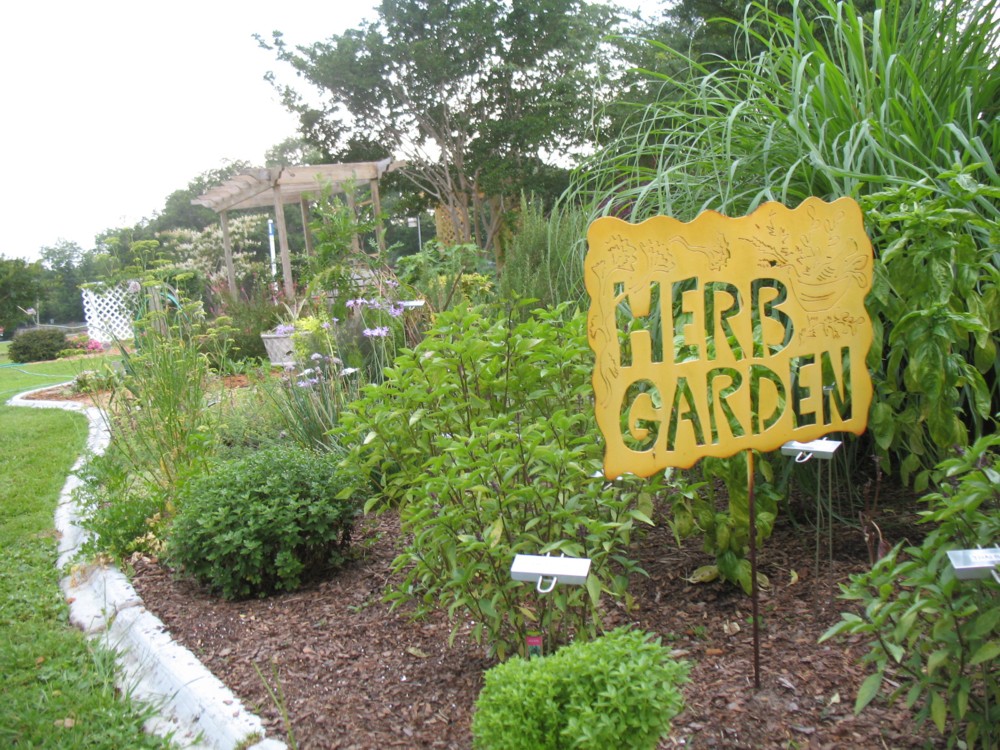
by Ashley Stonecipher | Dec 2, 2021
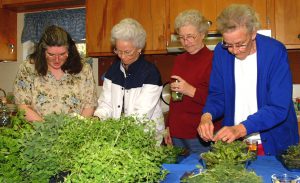
Women making vinegar at a class in Starke
Herbs are often underutilized in our cooking. There are many benefits of growing and using herbs. They add flavor to foods and beverages and reduce the need for salt, fat, and sugar. Herbs are also easy to grow at home and low maintenance!
Herbs can be used fresh, dried, and frozen. There are several tips of how to use herbs in your kitchen. You will need to adjust recipes depending on how the herb is prepared. For example, 1 tablespoon of finely cut fresh herbs equals 1 teaspoon of dried herbs and is equivalent to 1/4-1/2 teaspoon of ground dried herbs. It is always best to start with small amounts and add more to taste. Dried ground herbs can be used on meat, soups, sauces, and vegetables to name a few.
In hot dishes fresh herbs should be added near the end of the cooking time. If they are delicate herbs, you could do it in the last 1 to 2 minutes and less delicate herbs in the last 20 minutes of cooking. In cold dishes, herbs should be added several hours before serving or overnight. Each herb has its own flavor profile, so experiment and see which you like best! Some common herb and food combinations are basil and tomato products, rosemary and meats, sage and poultry, and mint and desserts. Have fun trying different combination of herbs and food and remember to start with little and add as needed for the desired taste!
Source: Minton, Emily and Maddox, Martha. 2018. “Cooking with Fresh Herbs.” UF/IFAS Extension. FCS8932/FY1209: Cooking with Fresh Herbs (ufl.edu)

by Ashley Stonecipher | Oct 28, 2021
As October gets by us and November quickly approaches, I would like to include the preparation on What to Plant? And What to Do? Some great annual plant choices are digitalis (foxglove), petunias, and Shasta daisy. There are many daffodil bulb varieties for North Florida including the following: Carlton, Fortune, Silver Charms, Thalia, and Sweetness. We will be getting into more of the cooler days, so this is a good time to start bulb onions and salad crops such as arugula, lettuce, and spinach. Dill, fennel, oregano, and sage are all herbs that can be planted throughout the fall months.
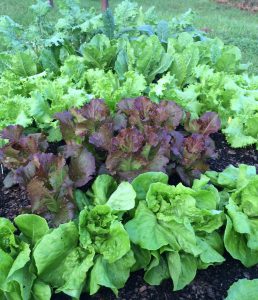
Start preparing now so your fall garden will be full of dark leafy greens, multi-colored lettuces, and root vegetables of all shapes and sizes. Photo by Molly Jameson.
In lawns there are a few key things that can be done in October. It is possible to control winter weeds before they appear. This is the time to use preemergent herbicides when nighttime temperatures are between 55-60 degrees Fahrenheit for four to five days in a row. If a green lawn is desired, you can overseed with annual ryegrass when the daytime temperatures are in the low 70s. Remember, the lawn will still need to be watered and mowed to maintain a healthy ryegrass. Watch for fungus like brown patch and large patch disease. This can become active when the soil temperature is between 65-75 degrees Fahrenheit.
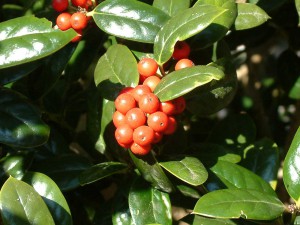
Hollies also attract bees to the landscape.
Credit: Beth Bolles, UF IFAS Extension Escambia County
And last but not least as you prepare for winter around the corner you can plant evergreen hollies that will make it through the cold and provide a splash of color with red berries. Gather pine needles that are dropping and use as a natural mulch, and this is the last month that strawberry plants can be established in a bed or a large container.
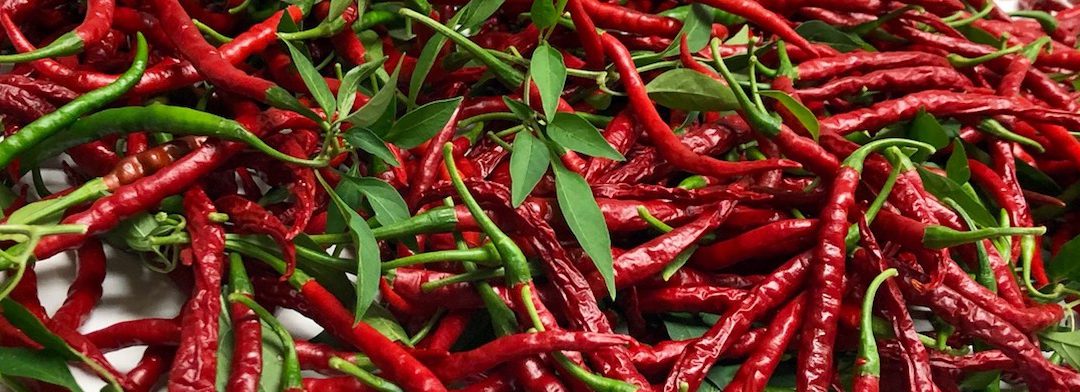
by Matthew Orwat | Sep 30, 2021
By Matthew Orwat and Judy Corbus
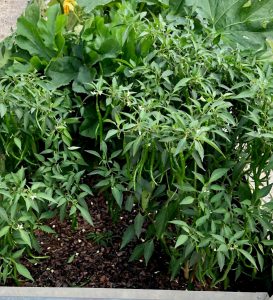
Cayenne Peppers growing this summer. Image Credit Matthew Orwat UF / IFAS Extension Washington County
As fall begins we often begin to think about the successes and failures of our vegetable gardens. Two of my successes this past summer have been pepper and basil.
A variety of peppers work great as transplants in mid to late spring. This spring a large variety of peppers were planted including Cayenne, Bell, Cubanelle, Habanero, Poblano, Anaheim, Cajun Belle, Havasau, Serrano, Jalapeno, and Banana. A loose, rich media was used containing coconut coir and composted organic humus to provide an excellent well-drained location which also retained moisture. Finding this delicate balance is difficult but can be achieved by using coconut coir and organic matter based garden soil mixtures. After the peppers were planted, they were side-dressed twice with a standard bagged 8-8-8 fertilizer blend containing micronutrients and once with an organic fertilizer. During the heat of the summer it was important to water the peppers at least every other day. Need for watering decreased as the fall weather approached, but was still necessary.
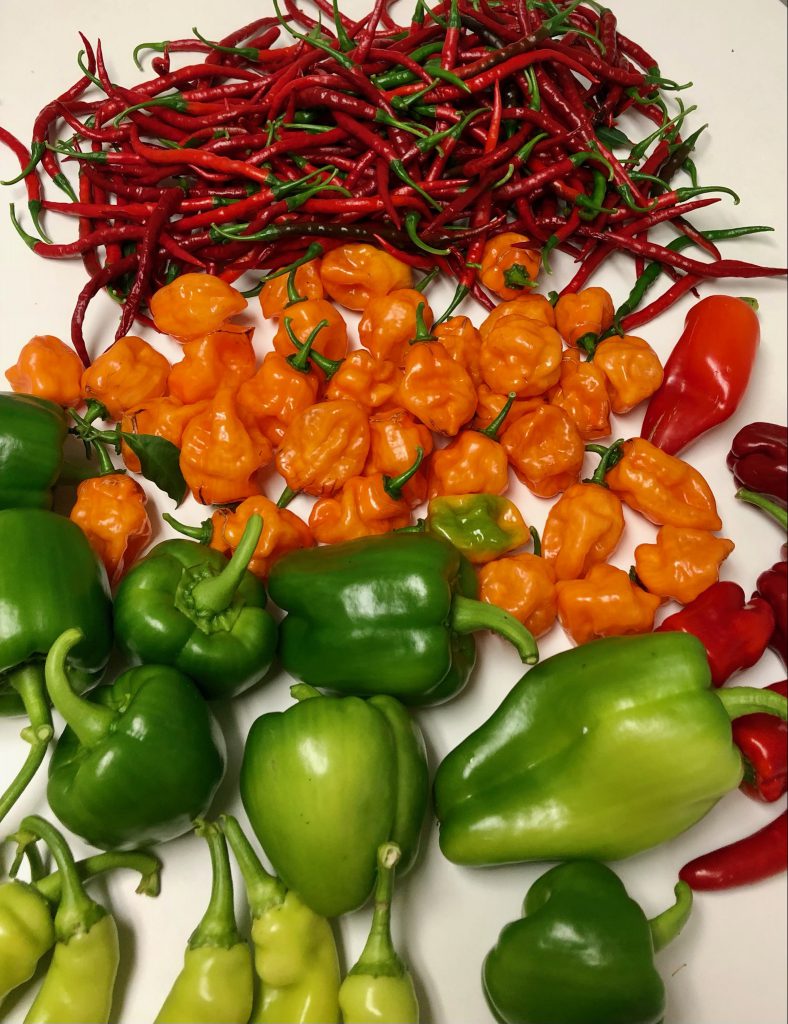
Bountiful Pepper Harvest. Image Credit Matthew Orwat UF / IFAS Extension Washington County
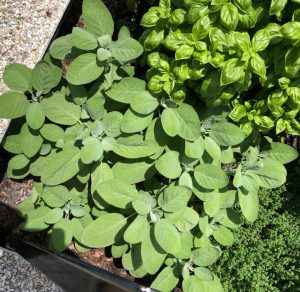
Sage and Basil Image Credit Matthew Orwat UF / IFAS Extension Washington County
In fall, many gardeners think it might be a good time to remove their peppers plants, but they can be encouraged to produce peppers until frost and maybe a little later with protection. Oftentimes it is more practical to start or transplant new pepper plants the following spring, but it is possible to pot up and overwinter peppers in a sheltered area or greenhouse.
In addition to peppers, basil was especially bountiful this year. To save my basil bounty for the winter I have options to dry, blanch or make pesto. This should be done before the first frost, since basil is very sensitive to freezing temperatures. Other herbs that will usually overwinter well in the garden include thyme, chives and rosemary. They will need little to no protection. Additionally, sage might come back the following year if it is in a protected area. Herbs such as cilantro and parsley will thrive in our North Florida winters and should be planted now.
To preserve the bounty of your harvest for later use, you may can, pickle, or freeze peppers. Follow these USDA-approved guidelines from the National Center for Home Food Preservation:
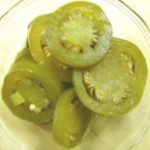
Credit : National Center for Home Food Preservation
Canning: https://nchfp.uga.edu/how/can_04/peppers.html
Pickling:
Freezing:
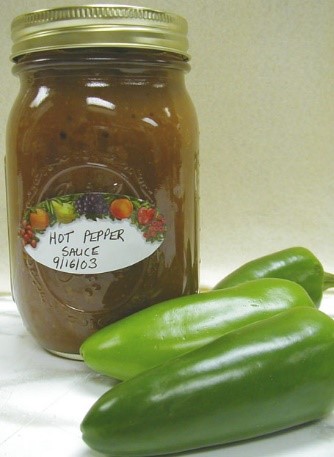

by Ashley Stonecipher | Sep 23, 2021
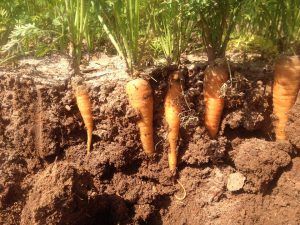
Photo by Full Earth Farm.
Yes, that’s right! We made it through the hottest part of the year and we are looking ahead to fall just around the corner! I am excited to be discussing September and what we can do to prepare for fall in the garden. As the nighttime temperatures start to cool down, we are given many more options.
For annual color plantings in September, try Ageratum, Celosia, Zinnias, and Wax Begonia to add fall color to your landscape. Bulbs will also add color, texture, and pattern to a bed. If you have some extra space, a variety of elephant ears could really accent a bed or you could always go with the classic calla, narcissus or zephyr lily. Popular vegetables to plant in North Florida in September are broccoli, carrot, cabbage, and collards. See Vegetable Gardening in Florida This is also the time of year to establish strawberry plants. Some great herbs to get started are Mexican tarragon, mint, rosemary, and basil.
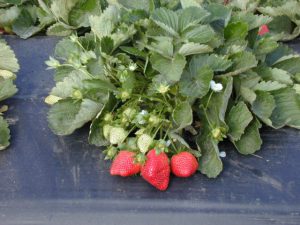
Image Credit: Matthew Orwat UF/IFAS Extension Washington County
There are many things that can be done in your lawn during September. Monitoring your lawn for its health and potential insect pests is important this time of year. Common insects to scout for are fall armyworms, chinch bugs, mole crickets, and sod webworms. The last fertilizer application should be done by the middle to end of September. Make sure you choose a fertilizer with little to no phosphorus unless a soil test shows differently. To maintain a healthy lawn, avoid weed and feed products and only apply herbicides in areas with high infestations of weeds. Weed and feed products are not recommended because the timing of when to fertilize and the timing of the weed killer is not always the same. The best management practice is to use a separate treatment for weeds and when possible spot treat weeds.
If you already have bulbs in your landscape from previous growing seasons, this is the time to divide and replant those that are big. You can also add organic matter to new planting areas. Continue working on your vegetable plants and prepare them for either transplants for a fast start, or plants seeds for more variety. Throughout your landscape, it is important that plants are getting the right amount of water as we go in and out of wet and dry weather this time of year.
October will be here before we know it in just a couple of weeks. Look out for the next article to come. We will be getting into the cooler nights and more options for planting vegetables and herbs!
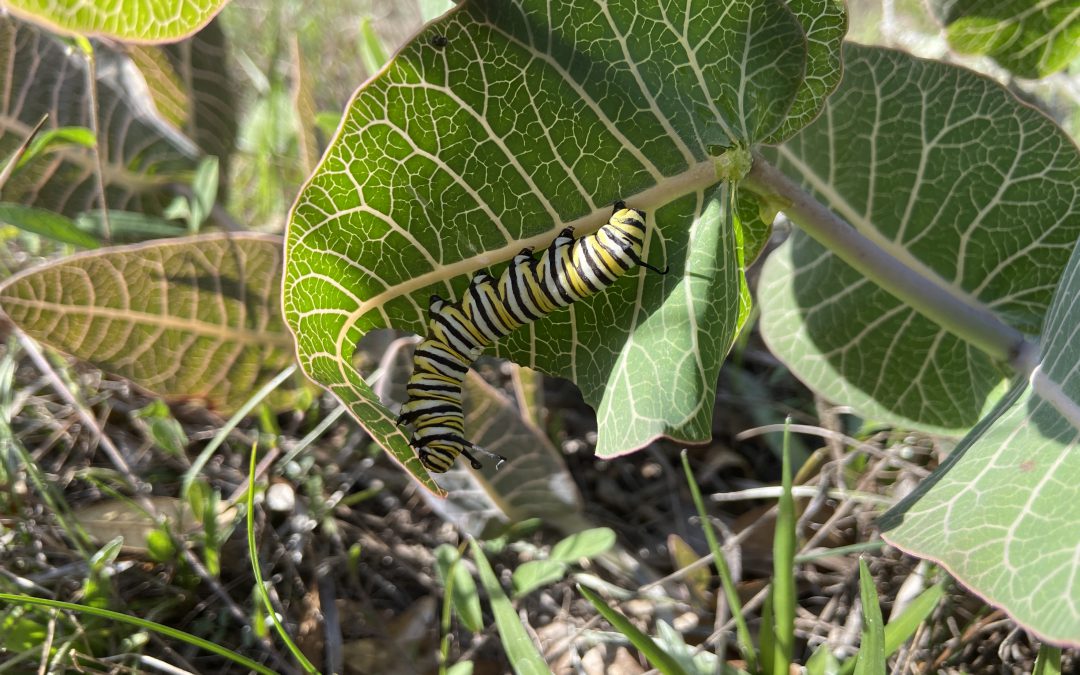
by Mary Salinas | Aug 20, 2021
On August 12, 2021, our panel answered questions on a wide variety of landscape topics. Maybe you are asking the same questions, so read on!
Ideas on choosing plants
What are some perennials that can be planted this late in the summer but will still bloom through the cooler months into fall?
Duranta erecta ‘Sapphire Showers’ or ‘Gold Mound’, firespike, Senna bicapsularis, shrimp plant, lion’s ear
Where can native plants be obtained?
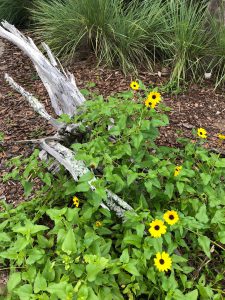
Dune sunflower, Helianthus debilis. Photo credit: Mary Salinas UF/IFAS Extension.
Gardening Solutions: Florida Native Plants – see link to FANN: https://gardeningsolutions.ifas.ufl.edu/plants/ornamentals/native-plants.html
What are some evergreen groundcover options for our area?
Mondo grass, Japanese plum yew, shore juniper, ajuga, ferns such as autumn fern.
What are some ideas for partial morning sun butterfly attracting tall flowers to plant now?
Milkweed, salt and pepper plant, swamp sunflower, dune sunflower, ironweed, porterweed, and salt bush.
I’m interested in moving away from a monoculture lawn. What are some suggestions for alternatives?
Perennial peanut, powderpuff mimosa, and frogfruit.
We are new to Florida and have questions about everything in our landscape.
Florida-Friendly-Landscaping TM Program and FFL Web Apps: https://ffl.ifas.ufl.edu/
https://ffl.ifas.ufl.edu/resources/apps/
UF IFAS Gardening Solutions: https://gardeningsolutions.ifas.ufl.edu/
What are some of the top trends in landscaping today?
Houseplants, edible gardens, native plants, food forests, attracting wildlife, container gardening, and zoysiagrass lawns
Edibles
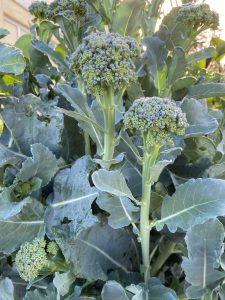
Artwork broccoli is a variety that produces small heads. Photo credit: Mary Salinas UF/IFAS Extension.
What vegetables are suitable for fall/winter gardening?
Cool Season Vegetables: https://gardeningsolutions.ifas.ufl.edu/plants/edibles/vegetables/cool-season-vegetables.html
North Florida Gardening Calendar: https://edis.ifas.ufl.edu/publication/EP451%20%20%20
Florida Vegetable Gardening Guide: https://edis.ifas.ufl.edu/publication/vh021
How can I add herbs to my landscape?
Herbs in the Florida Garden: https://gardeningsolutions.ifas.ufl.edu/plants/edibles/vegetables/herbs.html
My figs are green and hard. When do they ripen?
Why Won’t My Figs Ripen: https://www.lsuagcenter.com/profiles/rbogren/articles/page1597952870939
What is best soil for raised bed vegetable gardens?
Gardening in Raised Beds: https://edis.ifas.ufl.edu/publication/EP472
And there are always questions about weeds
How can I eradicate cogongrass?
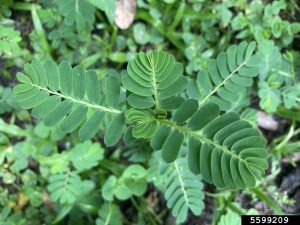
Chamber bitter is a troublesome warm season weed in our region. Photo credit: Brantlee Spakes Richter, University of Florida, Bugwood.org
Cogongrass: https://edis.ifas.ufl.edu/publication/WG202
Is it okay to use cardboard for weed control?
The Cardboard Controversy: https://gardenprofessors.com/the-cardboard-controversy/
What is the best way to control weeds in grass and landscape beds?
Weed Management Guide for Florida Lawns: https://edis.ifas.ufl.edu/publication/EP141
Improving Weed Control in Landscape Planting Beds: https://edis.ifas.ufl.edu/pdf/EP/EP52300.pdf
Landscape practices
Can ground water be brackish and stunt plants?
Reclaimed Water Use in the Landscape: https://edis.ifas.ufl.edu/publication/ss545
How can I prevent erosion from rainwater runoff?
Stormwater Runoff Control – NRCS: https://www.nrcs.usda.gov/wps/portal/nrcs/detail/national/water/?cid=nrcs144p2_027171
Rain Gardens: https://gardeningsolutions.ifas.ufl.edu/design/types-of-gardens/rain-gardens.html
And https://gardeningsolutions.ifas.ufl.edu/pdf/articles/rain-garden-manual-hillsborough.pdf
What is the best time of the year to propagate flowering trees in zone 8B?
Landscape Plant Propagation Information Page – UF/IFAS Env. Hort: https://hort.ifas.ufl.edu/database/lppi/
Which type of mulch works best on slopes greater than 3 percent?
Landscape Mulches: How Quickly do they Settle?: https://edis.ifas.ufl.edu/publication/FR052
When should bulbs be fertilized?
Bulbs and More – UI Extension: https://web.extension.illinois.edu/bulbs/planting.cfm
Should I cut the spent blooms of agapanthus?
Agapanthus, extending the bloom time: https://gardeningsolutions.ifas.ufl.edu/plants/ornamentals/agapanthus.html
http://blogs.ifas.ufl.edu/wakullaco/2020/10/07/extending-bloom-time/
Plant questions
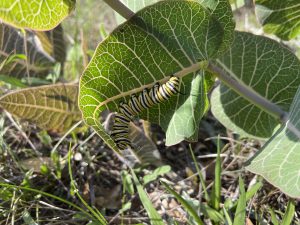
Monarch caterpillar munching on our native sandhill milkweed, Asclepias humistrata. Photo credit: Mary Salinas, UF IFAS Extension.
I planted native milkweed and have many monarch caterpillars. Should I protect them or leave them in nature?
It’s best to leave them in place. Featured Creatures: Monarch Butterfly: https://edis.ifas.ufl.edu/pdf/IN/IN780/IN780-Dxyup8sjiv.pdf
How does Vinca (periwinkle) do in direct sun? Will it make it through one of our panhandle summers? Can I plant in late August?
Periwinkles and No more fail with Cora series: https://gardeningsolutions.ifas.ufl.edu/plants/ornamentals/periwinkles.html#:~:text=Plant%20your%20periwinkles%20where%20they,rot%20if%20irrigated%20too%20frequently.
Insect and disease pests
What to do if you get termites in your raised bed?
The Facts About Termites and Mulch: https://edis.ifas.ufl.edu/publication/IN651
How to combat fungus?
Guidelines for ID and Management of Plant Disease Problems: https://edis.ifas.ufl.edu/publication/mg442
Are there preventative measures to prevent diseases when the humidity is very high and it is hot?
Fungi in Your Landscape by Maxine Hunter: http://blogs.ifas.ufl.edu/marionco/2020/01/16/fungi-in-your-landscape/
If you missed an episode, check out our playlist on YouTube https://www.youtube.com/watch?v=bp0HfdEkIQw&list=PLhgoAzWbtRXImdFE8Jdt0jsAOd-XldNCd





















